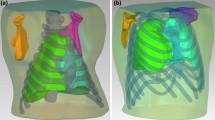Abstract
Air accumulations within living organisms are sometimes pathologic. An example is free air within the abdomen from perforation of the intestines (a condition called pneumoperitoneum). The objectives of the described research were to define the acoustic signatures of abdominal air cavities at low frequencies and to investigate the feasibility of using these signatures for pneumoperitoneum diagnosis. The central hypothesis was that low-frequency vibro-acoustic property changes are detectable using broad-band acoustic excitation applied at the abdominal surface. Band-limited white noise (0-3200 Hz) was introduced at the abdominal surface of sedated dogs and response was measured by a surface vibro-acoustic sensor. The transfer function and coherence were estimated from these measurements. The presence of pneumoperitoneum caused increased resonances and anti-resonances (p<0.01). Measures of the latter parameters were proposed and evaluated to quantitatively measure their magnitude. Resonant spectral peaks of more than 3dB were consistent with pneumoperitoneum (p<0.01), and both resonance and anti-resonance increased with condition severity (p<0.03). The data also suggest a possible reduction in the resonant and anti-resonant frequencies with decreasing air cavity volumes (p=0.14) as supported by theoretical predictions. Finally, anti-resonance was also found to be associated with a drop in coherence. These findings suggest that the proposed technique may be useful in the diagnosis of pneumoperitoneum.
Similar content being viewed by others
References
Baker, S. R. (1995): ‘Diagnosis of minimal to moderate pneumoperitoneum’,Abdom. Imaging,20, pp. 492–494
Baker, S. R. (1996): ‘Imaging of pneumoperitoneum’,Abdom. Imaging,21, pp. 413–414
Bejvan, S. M., andGodwin, J. D. (1996): ‘Pneumomediastinum: old signs and new signs’,AJR,166, pp. 1041–1048
Braccini, G., Lamacchia, M., Boraschi, P., Bertoletti, L., Marrucci, A., Goletti, O., andPerri, G. (1996): ‘Ultrasound versus plain film in the detection of pneumoperitoneum’,Abdom. Imaging,21, pp. 404–412
Cho, C. C., andBaker, S. R. (1994): ‘Extraluminal air: diagnosis and significance’,Radiol. Clin. N. Am.,32, pp. 829–844
Donnerberg, R. L., Druzgalski, C. K., Hamlin, R. L., Davis, G. L., Campbell, R. M., andRice, D. A. (1980): ‘Sound transfer function in the congested canine lung’,Br. J. Dis. Chest,74, pp. 23–31
Gao, L., Parker, K. J., Alam, S. K., andLerner, R. M. (1995): ‘Sonoelasticity imaging: theory and experimental verification’,J. Acoust. Soc. Am.,97, pp. 3875–3886
Kraman, S. S., andBohandana, A. B. (1989): ‘Transmission to the chest of sound introduced at the mouth’,J. Appl. Physiol.,66, pp. 278–281
Leighton, T. G. (1994): ‘The acoustic bubble’ (Academic Press, San Diego, CA), p. 139
Levine, M. S., Scheiner, J. D., Rubesin, S. E., Laufer, I., andHerlinger, H. (1991): ‘Diagnosis of pneumoperitoneum on supine abdominal radiographs’,Am. J. Radiol.,156, pp. 731–735
Menuck, L., andSiemers, P. T. (1976): ‘Pneumoperitoneum: importance of right upper quadrant features’,Am. J. Radiol.,127, pp. 753–756
Miller, R. F., andNelson, S. W. (1971): ‘The roentgenological demonstration of tiny amounts of free intra-peritoneal gas: experimental and clinical studies’,Am. J. Radiol.,112, pp. 574–585
Mirvis, S. E., Gens, D. R., andShanmuganathan, S. (1992): ‘Rupture of the bowel after blunt abdominal trauma: diagnosis with CT’,Am. J. Radiol.,159, pp. 1217–1221
Morse, P. M., andIngard, K. U. (1986): ‘Theoretical acoustics’ (Princeton University Press, Princeton, NJ), pp. 571
Miridha, M., andOdman, S. (1986): ‘Noninvasive method for the assessment of subcutaneous oedema’,Med. Biol. Eng. Comput.,24, pp. 393–398
Oestreicher, H. L. (1951): ‘Field and impedance of an oscillating sphere in viscoelastic medium with an application to biophysics’,J. Acoust. Soc. Am.,23, pp. 707–714
Prabavathi, C., andVendhan, C. P. (1994): ‘Calculation of the acoustic modes of spherical cavity by using wedge element’,J Sound Vibration,172, pp. 136–141
Paster, S. B., andBrogdon, B. G. (1976): ‘Roentgenographic diagnosis of pneumoperitoneum’,J. Am. Med. Assoc.,235, pp. 1264–1267
Pereira, J. M., Mansour, J. M., andDavis, B. R. (1990): ‘Analysis of shear wave propagation in skin: application to an experimental procedure’,J. Biomech.,23, pp. 745–751
Potts, R. O., Chrisman Jr, D. A., andBuras Jr, E. M. (1983): ‘The dynamic mechanical properties of human skinin vivo’,J. Biomech.,16, pp. 365–372
Royston, T. R., Mansy, H. A., andSandler, R. H. (1999): ‘Excitation and propagation of surface waves on a viscoelastic half space with application to medical diagnosis’,J. Acoust. Soc. Am.,106, pp. 3678–3686
Sherck, J., Shatney, C., Sensaki, K., andSelivanov, V. (1994): ‘The accuracy of computerized tomography in the diagnosis of blunt small bowel trauma’,Am. J. Surg.,168, pp. 670–675
Stapakis, J. C., andThickman, D. (1992): ‘Diagnosis of pneumoperitoneum: abdominal CT vs. upright chest film’,J. Comput. Assist. Tomogr.,16, pp. 713–716
Strassberg, M. (1953): ‘The pulsation frequency of nonspherical gas bubbles in liquids’,J. Acoust. Soc. Am.,25, pp. 536–539
Von Gierke, H. E., Oestreicher, H. L., Franke, E. K., Parrack, H. O., andVon Wittern, W. W. (1952): ‘Physics of vibrations in living tissues’,J. Appl. Physiol.,4, pp. 886–900
Wodicka, G. R., andShannon, D. C. (1990): ‘Transfer function of sound transmission in subglottal human respiratory system at low frequencies’,J. Appl. Physiol.,69, pp. 2126–2130
Wodicka, G. R., Aguirre, A., Defrain, P. D., andShannon, D. C. (1992): ‘Phase delay of pulmonary acoustic transmission from trachea to chest wall’,IEEE Trans. Biomed. Eng.,39, pp. 1053–1059
Wodicka, G. R., Lam, A. M., Bhargava, B., andSunkel, D. (1993): ‘Acoustic impedance of the maternal abdomen’,J. Acoust. Soc. Am.,94, pp. 13–18
Author information
Authors and Affiliations
Corresponding author
Rights and permissions
About this article
Cite this article
Mansy, H.A., Royston, T.J. & Sandler, R.H. Acoustic characteristics of air cavities at low audible frequencies with application to pneumoperitoneum detection. Med. Biol. Eng. Comput. 39, 159–167 (2001). https://doi.org/10.1007/BF02344798
Received:
Accepted:
Issue Date:
DOI: https://doi.org/10.1007/BF02344798




